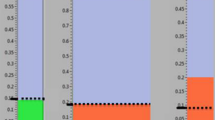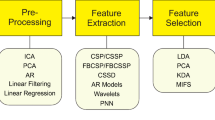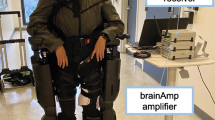Abstract
Neurofeedback training was proven to be applicable for treatment of various chronic pains including central neuropathic pain (CNP) owing to the ability of the brain to self-regulate its activities. This study reports on the performance of deep learning features-based brain–computer interface (BCI) in evaluating the efficacy of neurofeedback training carried out for treating paraplegic patients for CNP. Motor-imagery EEG (MI-EEG) data, in this study, was obtained from able-bodied (AB) participants, paraplegic patients with CNP (PPW), and paraplegic patients without CNP (PP). ResNet50 network was applied for obtaining deep learning features from MI-EEG; support vector machine (SVM) used for classifying obtained deep learning features. Following the SVM-based BCI was developed, new MI-EEG data obtained from the paraplegic patients who have completed neurofeedback sessions in order to evaluate the performance of SVM-based BCI. Results of this study demonstrate that the prediction accuracy of the developed BCI changes with MI task, groups of participants from which MI-EEG was obtained, and EEG channels combination. The highest efficiency of the BCI, with an accuracy of 99.94 ± 0.05 %, was gained with MI-EEG of the feet, AB vs PP group, and combination C4 over the sensorimotor cortex. In conclusion, deep learning features-based BCI can be applied efficiently to evaluate the efficacy of neurofeedback training applied for treating paraplegic patients for CNP. This study provides significant implications for improving the efficiency of MI-EEG-based BCIs.




Similar content being viewed by others
Availability of Data and Materials
The data that support the findings of this study are available on request from the corresponding author M.G.S. The data are not publicly available due to restrictions written down in informed consent obtained from the participants.
Code Availability
The code used to analyze the data of this study is available on request from the corresponding author M.G.S.
References
Sahonero-Alvarez G, Singh AK, Sayrafian K, Bianchi L, Roman-Gonzalez A. A functional BCI model by the P2731 working group: transducer. Brain-Comput Interfac. 2021;8(3):92–107. https://doi.org/10.1080/2326263X.2021.1968633.
Lotte F, Roy RN. Brain–computer interface contributions to neuroergonomics. In: Neuroergonomics. Elsevier; 2019. p. 43–8.
Chiarelli AM, et al. Simultaneous functional near-infrared spectroscopy and electroencephalography for monitoring of human brain activity and oxygenation: a review. Neurophotonics. 2017;4(4):041411. https://doi.org/10.1117/1.NPh.4.4.041411.
Ahn M, et al. A review of brain-computer interface games and an opinion survey from researchers, developers and users. Sensors. 2014;14(8):14601–33. https://doi.org/10.3390/s140814601.
Tabar YR, Ugur H. A novel deep learning approach for classification of EEG motor imagery signals. J Neural Eng. 2016;14(1):016003. https://doi.org/10.1088/1741-2560/14/1/016003.
Vuckovic A, et al. Dynamic oscillatory signatures of central neuropathic pain in spinal cord injury. J Pain. 2014;15(6):645–55. https://doi.org/10.1016/j.jpain.2014.02.005.
Deivasigamani S, et al. Machine learning method based detection and diagnosis for epilepsy in EEG signal. J Ambient Intell Hum Comput. 2021;12(3):4215–21. https://doi.org/10.1007/s12652-020-01816-3.
Lim CG, et al. A randomized controlled trial of a brain-computer interface based attention training program for ADHD. PLoS ONE. 2019;14(5):e0216225. https://doi.org/10.1371/journal.pone.0216225.
Saif MGM, Hassan MA, Vuckovic AJSAS. Efficacy evaluation of neurofeedback applied for treatment of central neuropathic pain using machine learning. SN Appl Sci. 2021;3(1):58. https://doi.org/10.1007/s42452-020-04035-9.
Vukelić M, et al. Different oscillatory entrainment of cortical networks during motor imagery and neurofeedback in right and left handers. Neuroimage. 2019;195:190–202. https://doi.org/10.1016/j.neuroimage.2019.03.067.
Stern J, Jeanmonod D, Sarnthein JJN. Persistent EEG overactivation in the cortical pain matrix of neurogenic pain patients. Neuroimage. 2006;31(2):721–31. https://doi.org/10.1016/j.neuroimage.2005.12.042.
Hasan MA, et al. Reversed cortical over-activity during movement imagination following neurofeedback treatment for central neuropathic pain. Clin Neurophysiol. 2016;127(9):3118–27. https://doi.org/10.1016/j.clinph.2016.06.012.
Dai M, et al. EEG classification of motor imagery using a novel deep Learning framework. Sensors. 2019;19(3):551. https://doi.org/10.3390/s19030551.
Neuper C, Pfurtscheller GJB-CI. Neurofeedback training for BCI control. Berlin Heidelberg: Springer; 2009. p. 65–78.
Li M-A, et al. Automatic feature extraction and fusion recognition of motor imagery EEG using multilevel multiscale CNN. Med Biol Eng Comput. 2021;59(10):2037–50. https://doi.org/10.1007/s11517-021-02396-w.
Hermosilla DM, et al. Shallow convolutional network excel for classifying motor imagery EEG in BCI applications. IEEE Access. 2021;9:98275–86. https://doi.org/10.1109/ACCESS.2021.3091399.
LeCun Y, Bengio Y, Hinton G. Deep learning. Nature. 2015;521(7553):436–44. https://doi.org/10.1038/nature14539.
Gustin SM, et al. Brain circuitry underlying pain in response to imagined movement in people with spinal cord injury. PAIN®. 2010;148(3):438–45. https://doi.org/10.1016/j.pain.2009.12.001.
Jensen MP, et al. Steps toward developing an EEG biofeedback treatment for chronic pain. Appl Psychophysiol Biofeedback. 2013;38(2):101–8. https://doi.org/10.1007/s10484-013-9214-9.
Sarnthein J, et al. Increased EEG power and slowed dominant frequency in patients with neurogenic pain. Brain. 2006;129(1):55–64. https://doi.org/10.1093/brain/awh631.
Formaggio E, et al. Brain oscillatory activity during motor imagery in EEG-fMRI coregistration. Magn Reson Imaging. 2010;28(10):1403–12. https://doi.org/10.1016/j.mri.2010.06.030.
He K, et al. Deep residual learning for image recognition. In: Proceedings of the IEEE conference on computer vision and pattern recognition. Las Vegas, NV, USA, 2016, pp. 770–778. https://doi.org/10.1109/CVPR.2016.90.
Caliskan A, Suleyman R. Transfer learning to detect neonatal seizure from electroencephalography signals. Neural Comput Applic. 2021;33(18):12087–101. https://doi.org/10.1007/s00521-021-05878-y.
Shajil N, Sasikala M, Arunnagiri A. Deep learning classification of two-class motor imagery EEG signals using transfer learning. 2020 International Conference on e-Health and Bioengineering (EHB). Iasi, Romania: IEEE; 2020. p. 1–4. https://doi.org/10.1109/EHB50910.2020.9280257.
Mahmood A, et al. Automatic hierarchical classification of kelps using deep residual features. Sensors. 2020;20(2):447. https://doi.org/10.3390/s20020447.
Demir F, et al. Exploring deep learning features for automatic classification of human emotion using EEG rhythms. IEEE Sens J. 2021;21(13):14923–30. https://doi.org/10.1109/JSEN.2021.3070373.
Acknowledgements
We thank Dr. Purcell and Dr. Mclean, Southern General Hospital, Glasgow, for choosing participants of the study and to all participants for taking part. We thank Dr. Muhammad Abul Hasan and Dr. A. Vuckovic as well for their efforts in data processing. This work has been partially supported by the MRC grant G0902257/1, the Glasgow Research Partnership in Engineering, NED University of Pakistan PhD scholarship, and Ministry of Higher Education and Scientific Research of the Republic of Yemen.
Funding
Not applicable.
Author information
Authors and Affiliations
Corresponding author
Ethics declarations
Conflict of Interest
This research study is related to the master’s thesis of the corresponding author, and all authors declare that there is no conflict of interests regarding publication of this paper.
Ethical Approval
Informed consent was obtained from all participants, and the ethical approval to the trials was granted from the University of Strathclyde Ethical Committee and from National Health Service Ethical Committee for Greater Glasgow and Clyde.
Consent to Participate
Informed consent was obtained from all participants.
Consent for Publication
All authors have given their consent to publish.
Additional information
Publisher's Note
Springer Nature remains neutral with regard to jurisdictional claims in published maps and institutional affiliations.
Rights and permissions
Springer Nature or its licensor (e.g. a society or other partner) holds exclusive rights to this article under a publishing agreement with the author(s) or other rightsholder(s); author self-archiving of the accepted manuscript version of this article is solely governed by the terms of such publishing agreement and applicable law.
About this article
Cite this article
Saif, M.G.M., Sushkova, L. & Fraser, M. Evaluation of Neurofeedback Therapy for Treatment of Central Neuropathic Pain in Paraplegic Patients Using Deep Learning. SN COMPUT. SCI. 4, 598 (2023). https://doi.org/10.1007/s42979-023-02183-4
Received:
Accepted:
Published:
DOI: https://doi.org/10.1007/s42979-023-02183-4




